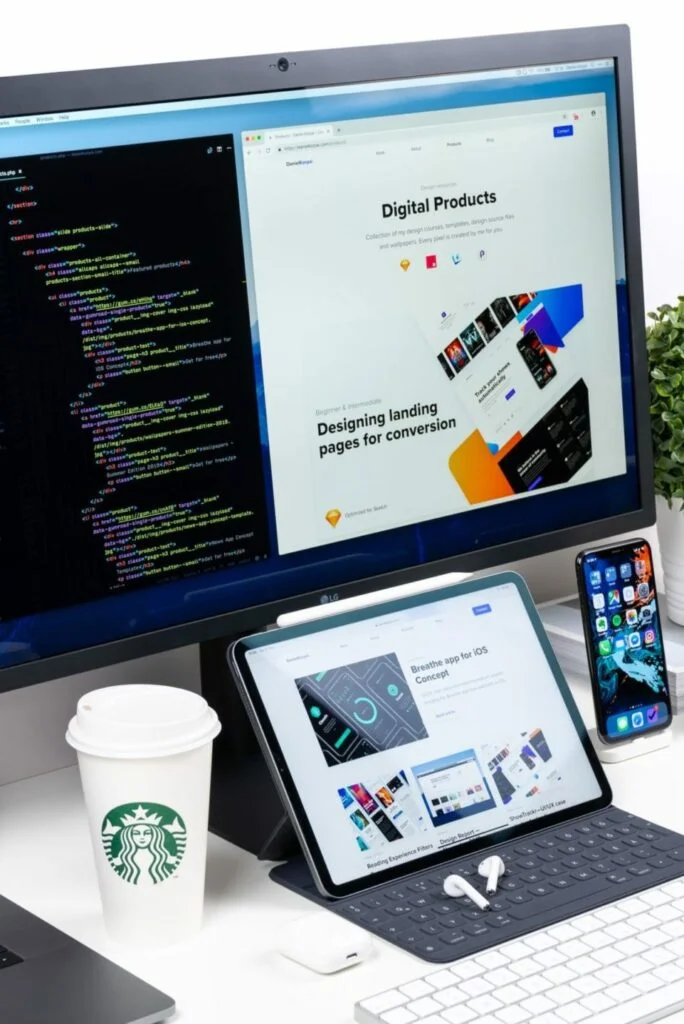Websites are no longer a luxury; they’re now necessary for businesses to remain competitive in nearly all industries. An effective website can help you acquire new customers, sell products and services, and build your brand.
Conversely, a poor web design can lose your business. If your website is outdated, hard to navigate, or provides a bad user experience, visitors will likely leave without taking any desired action. Therefore, website builders must consider the functionality and usability of a site whether starting a new website or redesigning an existing one. Before we proceed, let’s learn the basics of web design in web development.
What Is Web Design?
Web design refers to the process of creating websites. It encompasses several aspects, including web page layout, mobile apps, content production, user interface design, and graphic design.
While “web design” usually refers to visual design, it can also include coding and creating markup. Web designers use various tools to develop websites, including Adobe Photoshop, Illustrator, and InDesign.
What Is the Purpose of Web Interface Design?
Website design aims to create a compelling and appealing website for users. A good web designer will have the necessary skills for designing websites that are both effective and appealing.
Now that we’ve learned the basics, let’s look at the functional elements that will help your website stand out from the competition.
Simplicity (Simple, Clean and Consistent Design)
Web development and design should be kept simple. A website with a simple, clean design is much easier to navigate than one with a cluttered layout.
Too much information or too many graphics can be overwhelming and distracting for readers, leading them to leave the site prematurely. When designing your website, focus on using simple, well-organized layouts and keeping the number of graphics to a minimum.
The web design industry has been moving toward responsive design for years, and it’s now considered standard practice. Many design elements, such as fonts, images, and navigation menus, need to be sized and appropriately formatted to look good on all devices.
A well-designed website should also have a consistent design throughout. The fonts, colors, and layout should be the same on all web pages. This will create a cohesive and professional look for your website.
Easy Navigation
A good web design should be easy to use, understand and navigate. The interface should be intuitive and the navigation straightforward. Visitors need to find what they’re looking for quickly and easily without having to search through many pages.
Navigation menus should be prominent and easy to understand. Pages should be logically organized so that visitors can find what they’re looking for with minimal effort.
Your website should have a clean design with plenty of negative space to achieve simplicity. The layout should be grid-based, and the fonts should be easy to read.

Complimenting Web Content
The content on your website should complement the design. The two should work together to create a cohesive user experience.
Your content should be well-written, accurate, and informative. It should also be relevant to your business and audience. It should be formatted with appropriate use of headings, subheadings, and bullet points. If you need help writing content for your site, you can hire professionals like copywriters or ghostwriters who specialize in web content.
User Experience (UX)
User experience design is one of the most important aspects of web design. UX refers to the overall experience when interacting with your website. Some of the key factors that affect UX are a website’s navigation, its layout, and the general flow of the web browser’s journey through the site.
Creating a good user experience starts with understanding your target audience and their needs. Once you know what they want, you can design your website to meet those needs.
The goal of good UX is to make the user’s interaction with the site as simple and efficient as possible. An effective UX design will take into account the user’s needs and desires as well as the business goals of the website.
Some ways to improve the UX of your website include:
- Creating a straightforward and easy-to-use navigation menu
- Using negative space, color, and other design elements to create visual interest and contrast
- Writing clear and concise content that is easy to scan and understand
- Optimizing web pages for loading speed
Web Graphic Design
Graphic design is creating visual elements such as images, logos, infographics, and illustrations. A good web graphic designer will have a strong understanding of color theory, typography, and layout. They will also be skilled in using various design software programs such as Adobe Photoshop and Illustrator.
Large, high-quality images can make your website look more professional and appealing. However, you should avoid using too many images, making your website slow to load. Images should be optimized for different devices and screen sizes.
Some ways to improve the graphic design of your website include:
- Using high-quality images that are relevant to your business.
- Creating a consistent color scheme
- Using whitespace to create visual interest
- Designing custom logos and graphics

Web Typography
Typography is the process of choosing and using fonts for web pages. A good web typographer will have a strong understanding of how fonts work and use them effectively. They will also be skilled in using various design software programs such as Adobe Photoshop and Illustrator.
Some ways to improve the typography of your website include:
- Choosing fonts that are easy to read
- Using a limited number of fonts.
- Creating a consistent typeface throughout the website
Responsive Design
One of the essential web design elements is responsiveness. Your website should be responsive to different devices and screen sizes. A responsive website’s design adapts to the device it is being viewed on, whether it’s a desktop computer, a phone, or a tablet. With so many people now using different devices to access the web, it’s essential that your website looks great and functions correctly on all of them.
Site visitors should have an enjoyable experience no matter what device they’re using to view your website. Web design tools and frameworks can help you create a responsive website. Examples include Froont, Bootstrap, Webflow, and Foundation.
Some ways to improve the responsive design of your website include:
- Designing for different screen sizes.
- Optimizing images for other devices.
- Using media queries to create a responsive layout.
Web Accessibility
Web accessibility refers to the process of making websites accessible to people with disabilities. A good web builder will have a strong understanding of how to design websites with accessibility in mind. Web builders should also be skilled in using various design software programs and frameworks such as WAVE and WebAIM.
Web builders will improve the accessibility of your website by:
- Using accessible HTML (Hypertext Markup Language) tags
- Using accessible fonts and colors
- Providing alternate text for images
- Creating a clear and easy-to-use navigation menu

Aesthetics
While the UX of a website is important, aesthetics are also vital in keeping visitors engaged. Your site’s overall look and feel should be consistent with your brand and reflect the type of business you are in.
For example, a particular website, a luxury fashion brand, would want its website to have a sleek and sophisticated design, while an outdoor adventure company might wish for a more rugged and outdoor-themed aesthetic. A good website builder design a site customized to best fit your brand.
Some factors to consider when choosing the right aesthetics for your website include:
- Selecting an appropriate color scheme
- Using high-quality images and videos
- Utilizing negative space to create a clean and uncluttered look
- Using consistent themes with other brand assets, like your logo
Search Engine Optimization (SEO)
Search engine optimization is the process of optimizing your website to rank higher in search engine results pages (SERPs), making it more likely that people will find your site. The search engine optimization of your website is essential to users finding your pages when they use search engines.
Good SEO involves optimizing your website’s written content, titles, meta descriptions, and other elements for keywords that people are likely to search for.
Some tips for improving your SEO include:
- Researching the right keywords to target
- Optimizing your website content for those keywords
- Using catchy title tags and meta descriptions
- Creating backlinks to your website

Mobile-Friendliness
With most people now accessing the internet from their mobile devices, it’s more important than ever for web designers to make sure your website is optimized. This means having a responsive design that automatically adjusts to fit any screen size and ensuring that your website content is easy to read and navigate on a smaller screen.
Some tips for making your website mobile-friendly include:
- Designing a website using a responsive design
- Make sure your content is well laid out and easy to read
- Ensuring your website loads quickly on mobile devices
Page Load Time
Your website should load quickly (in just a few seconds), no matter which device it’s being viewed on. If it takes too long, visitors may get impatient and leave.
Many factors contribute to a website’s load time, such as the number of images and videos used, the hosting service you have, and the size of your files. Your graphic designer can use online tools like Pingdom or GTMetrix to test your website’s loading time and identify ways to improve it.
The loading speed of your web pages is essential for two reasons: first, because slow load times will frustrate visitors and make them more likely to leave; and second, because Google takes page speed into account when determining your website’s ranking in search engine results pages (SERPs).
Slow website speeds can be caused by many factors, including file size, images, videos, and your website’s code. Users’ internet connection and the device also play a role. A web designer will troubleshoot and fix any issues causing your pages to load slowly.
Some helpful tips to improve page speed include:
- Reducing your video file sizes
- Compressing your website’s files
- Optimizing your images for the web
- Reducing your website’s code
- Minifying your CSS and JavaScript
- Using a content delivery network (CDN)

Coding
The coding of a website is essential for creating a well-functioning website. Websites are coded in various programming languages, such as HTML (Hypertext Markup Language), CSS (Cascading Style Sheets), and JavaScript. Good coding practices will ensure that your website is easy to use and navigate, looks good on all devices, and loads quickly. Many web designers use frameworks such as Bootstrap or Foundation to speed up the coding process.
Some tips for good coding practices include:
- Using a code editor
- Organizing your code using folders
- Commenting your code
- Using a CSS preprocessor
- Using a JavaScript library
- Using valid code
- Using semantic markup
- Optimizing your code for performance
- Including fallbacks for older browsers
Security
In today’s online world, security is more important than ever. With hackers becoming more sophisticated and cybercrime on the rise, it’s essential to ensure your website is secure from potential attacks. This includes providing that your site is SSL encrypted and taking measures to prevent malware and other security threats.
Some ways to improve the security of your website include:
- Installing an SSL certificate
- Keeping your software and plugins up to date
- Using a security plugin or service
- Using a strong password policy
- Securing your Wi-Fi network
FAQs
u003cmeta charset=u0022utf-8u0022u003eWhat does a web designer do?
u003cmeta charset=u0022utf-8u0022u003eWeb designers are responsible for the look and feel of a website and its usability and functionality. They create the site’s overall design and then write the code to make it a reality. They also work with clients to get a clear understanding of their needs and goals for the site.
u003cmeta charset=u0022utf-8u0022u003eAre web designers paid well?
u003cmeta charset=u0022utf-8u0022u003eWeb designers typically earn a good salary, depending on their level of experience and the type of work they do. Junior designers may start making around $35,000 per year, while more experienced designers can earn upwards of $100,000.
Conclusion
Web design is a complex process involving many different skills and technologies. It’s essential to choose the right type of design for your website based on your needs and the type of content you’re publishing. A good web designer will create an attractive and user-friendly website that meets your specific needs.
Hire our Vt web design agency to design your website today!
Thank you for reading! We hope this article was helpful. If you have any questions, please don’t hesitate to contact us today.
